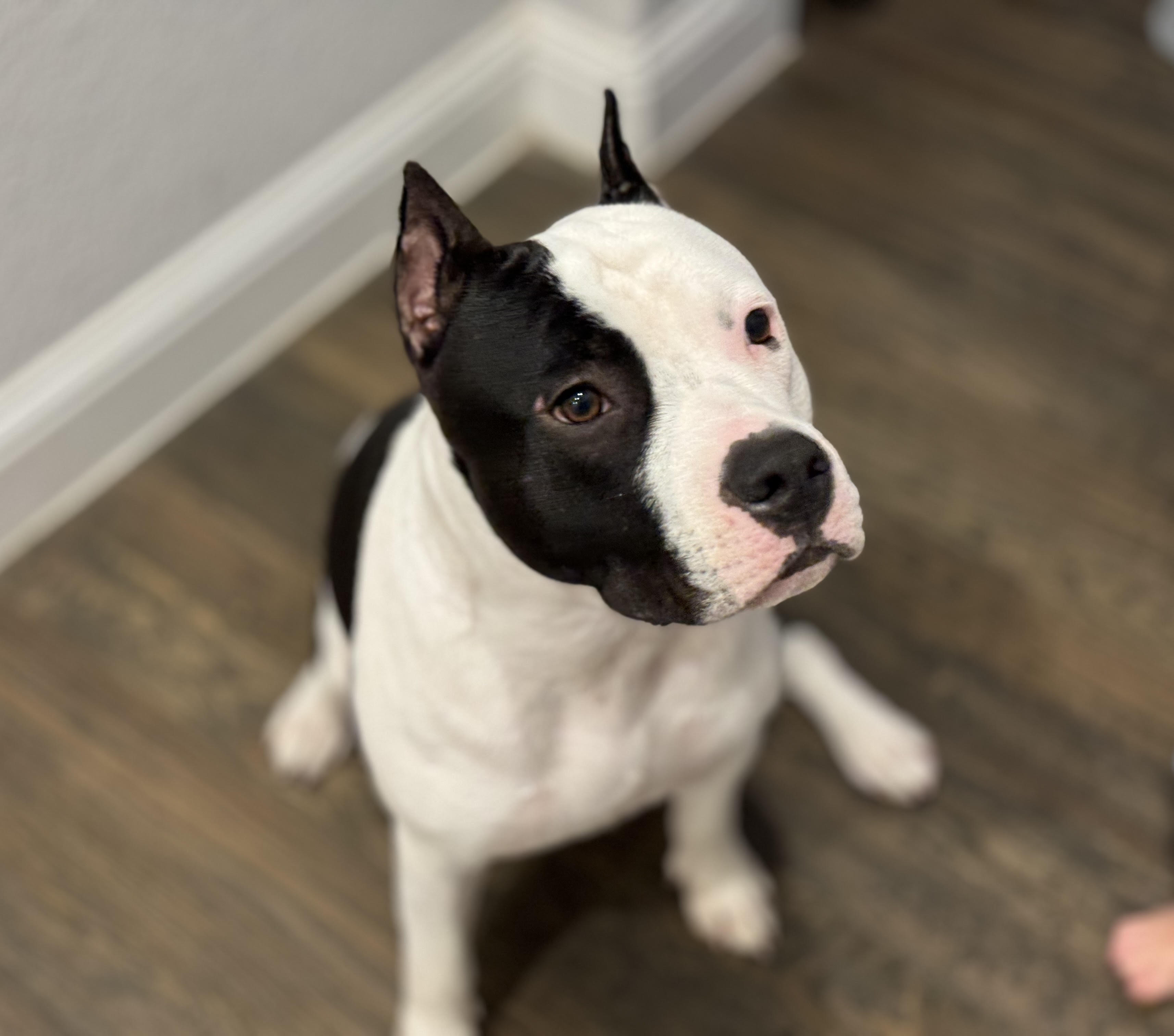At times, American Staffordshire Terriers (AmStaffs) may exhibit behavioral problems that can be challenging for their owners to address. Understanding the causes behind these issues is crucial in finding effective solutions to improve their behavior. In this section, we will explore the various behavioral problems that AmStaffs may experience and provide practical advice on how to tackle these issues.

Key Takeaways:
- Behavioral problems can arise in American Staffordshire Terriers (AmStaffs).
- Understanding the causes behind these issues is essential in finding solutions.
- Proper training and behavioral modification techniques can help address these problems.
- Creating a positive environment is crucial for AmStaffs to exhibit good behavior.
- Consistency and patience are key when addressing behavioral issues in AmStaffs.
Understanding Aggression in AmStaffs
Aggression is a common behavioral problem seen in American Staffordshire Terriers, or AmStaffs. It is important for AmStaff owners to understand the reasons behind their dog’s aggressive behavior in order to effectively manage and address the issue. In this section, we will discuss the causes of aggression in AmStaffs and provide strategies to address this challenging problem.
Aggression in AmStaffs can stem from various factors, including genetics, socialization, fear, or past traumas. When left unaddressed, aggression can pose a risk to the dog’s overall well-being, as well as the safety of those around them. Therefore, it is crucial to take proactive steps to address this behavior and provide a safe environment for both the dog and others.
To effectively manage aggression in AmStaffs, it is recommended to consult with a professional dog trainer or animal behaviorist who specializes in working with aggressive dogs. They can assess the specific triggers and underlying causes of aggression and develop a tailored training plan to address the issue.
Training techniques that focus on positive reinforcement and reward-based methods are often the most effective for addressing aggression in AmStaffs. These techniques help redirect the dog’s behavior towards more desirable actions and build trust and confidence.
Key strategies for addressing aggression in AmStaffs:
- Consistent and structured training sessions to establish boundaries and reinforce desired behaviors.
- Proper socialization from an early age to help the dog become comfortable and confident around other animals and people.
- Identifying and avoiding triggers that may provoke aggressive behavior in your AmStaff.
- Implementing positive reinforcement techniques, such as rewarding good behavior with treats, praise, and play.
- Using behavior modification exercises to desensitize the dog to potential triggers and teach new coping mechanisms.
It is essential to remember that addressing aggression in AmStaffs requires patience, consistency, and dedication. Progress may take time, but with the right approach and professional guidance, it is possible to help your AmStaff overcome aggression and become a well-adjusted and happy companion.
Dog Training Success Story
“My AmStaff, Max, used to exhibit aggressive behavior towards strangers and other dogs. With the help of a professional dog trainer, we implemented a training plan that focused on positive reinforcement and behavior modification techniques. Through consistent training sessions and socialization exercises, Max’s aggression has significantly decreased, and he is now able to enjoy positive interactions with other animals and people. I am grateful for the guidance and support we received, and it has made a remarkable difference in Max’s behavior and overall quality of life.”
Remember, seeking professional help when dealing with aggression in AmStaffs is essential to ensure safe and effective training.
| Causes of Aggression in AmStaffs | Management and Training Strategies |
|---|---|
| Genetic predisposition | Implement positive reinforcement techniques |
| Lack of socialization | Consistent and structured training sessions |
| Past traumas or abuse | Identify and avoid triggers |
| Fear or anxiety | Behavior modification exercises |
Obedience Training Challenges for AmStaffs
Training an AmStaff can be a rewarding experience, but it also comes with its fair share of challenges. AmStaffs are known for their strong-willed and independent nature, which can sometimes make obedience training a bit more difficult compared to other breeds. To help you navigate these challenges, we have compiled a list of tips and strategies to make your AmStaff’s obedience training a success.
The Importance of Consistency and Patience
Consistency is key when training an AmStaff. Establishing a consistent routine and using consistent commands will help your dog understand what is expected of them. Be patient and understanding with your AmStaff as they may take longer to grasp certain commands. Remember, every dog learns at their own pace, and it is important to remain calm and positive throughout the training process.
Positive Reinforcement and Rewards
AmStaffs respond well to positive reinforcement techniques. Reward your dog with praise, treats, or playtime when they successfully follow a command. This positive association will motivate your AmStaff to repeat the desired behavior. Avoid using harsh punishments or negative reinforcement methods as they can be counterproductive and may lead to fear or aggression.
Structured Training Sessions
Structured training sessions are essential for AmStaffs. Plan short, focused training sessions of about 10-15 minutes each, several times a day. This will help maintain your dog’s attention and prevent them from becoming bored or tired. Break down complex commands into smaller, more manageable steps, gradually increasing the difficulty as your AmStaff becomes more proficient.
Enroll in Obedience Classes
Enrolling your AmStaff in obedience classes can be highly beneficial. These classes provide a structured environment with professional trainers who have experience working with AmStaffs and understanding their specific needs. Additionally, obedience classes provide opportunities for socialization with other dogs, helping your AmStaff develop good manners and appropriate behavior around others.
By implementing these tips and strategies, you can overcome the obedience training challenges often faced with AmStaffs. Remember to be patient, consistent, and reward your furry friend for their efforts. With time and dedication, your AmStaff will become a well-behaved and obedient companion.

When dealing with behavioral problems in AmStaffs, it’s important to consider behavioral modification techniques to address and correct undesired behavior. In this section, we will discuss various methods and strategies that can be applied to modify and improve the behavior of your AmStaff.
Positive Reinforcement Training
One effective technique for behavioral modification in AmStaffs is positive reinforcement training. By rewarding desired behaviors with treats, praise, or playtime, you can encourage your AmStaff to repeat those behaviors. Positive reinforcement helps create a positive association with good behavior, making it more likely for your AmStaff to exhibit the desired behavior consistently.
Redirecting Unwanted Behavior
Another approach to behavioral modification is redirecting unwanted behavior. When your AmStaff engages in undesirable behavior, such as excessive barking or chewing, it’s important to redirect their attention to more appropriate activities. For example, if your AmStaff starts chewing on furniture, provide them with a chew toy or bone to redirect their chewing behavior.
Consistency and Patience
Consistency and patience are key when it comes to modifying AmStaff behavior. Establish clear rules and boundaries, and ensure that all family members or caretakers follow them consistently. Set realistic expectations and be patient with the process. It may take time for your AmStaff to fully adjust to the behavioral modifications.
Professional Guidance
If you’re struggling with addressing behavioral problems in your AmStaff, seeking professional guidance from a certified dog trainer or behaviorist can be immensely helpful. They can assess your AmStaff’s behavior, provide expert advice, and design a customized training program to address specific behavioral issues.
It’s important to remember that each AmStaff is unique, and what works for one dog may not work for another. Be patient and persistent, and always prioritize positive reinforcement and reward-based training methods. With dedicated effort and the right techniques, you can successfully modify your AmStaff’s behavior and create a well-behaved and happy companion.
Tips for AmStaff Behavioral Training
When it comes to your AmStaff’s behavior, effective training is key. By implementing the right techniques and strategies, you can shape your AmStaff’s behavior and ensure they grow into well-behaved and obedient companion.
To help you in this endeavor, we have compiled a list of practical tips and advice for conducting successful behavioral training sessions with your AmStaff:
- Start early: Begin training your AmStaff as early as possible to establish good behavior patterns from the start.
- Use positive reinforcement: Reward your AmStaff with treats, praise, and affection when they exhibit desired behaviors. This will reinforce positive behavior and motivate them to repeat it.
- Be consistent: Ensure that everyone in your household follows the same training methods and uses consistent cues and commands. Consistency is crucial for successful training.
- Keep sessions short and frequent: Short and frequent training sessions are more effective than long, infrequent ones. Aim for 10-15 minutes of focused training each day.
- Focus on socialization: Expose your AmStaff to various people, animals, and environments to help them become well-adjusted and socialized.
- Use clicker training: Clicker training is a popular and effective method that uses a clicker to mark desired behaviors. It helps reinforce positive behavior and improves communication between you and your AmStaff.
- Take professional training classes: Consider enrolling your AmStaff in professional obedience classes or working with a certified dog trainer who has experience with the breed.
Remember, training your AmStaff requires patience, consistency, and positive reinforcement. With dedication and the right approach, you can effectively correct any behavioral issues and foster a strong bond with your AmStaff.
“Training your AmStaff requires patience, consistency, and positive reinforcement.”
| Behavioral Training Tips | Description |
|---|---|
| Start early | Begin training your AmStaff from a young age to establish good behavior patterns. |
| Use positive reinforcement | Reward your AmStaff for displaying desired behaviors with treats, praise, and affection. |
| Be consistent | Ensure everyone in your household follows consistent training methods and commands. |
| Keep sessions short and frequent | Opt for shorter and frequent training sessions rather than long, infrequent ones. |
| Focus on socialization | Expose your AmStaff to different people, animals, and environments to promote sociability. |
| Use clicker training | Utilize clicker training to mark desired behaviors and improve communication. |
| Take professional training classes | Consider enrolling your AmStaff in professional obedience classes or working with a certified dog trainer. |
Common Behavioral Problems in AmStaffs
When it comes to American Staffordshire Terriers (AmStaffs), it’s essential to be aware of the potential behavioral problems they may experience. Understanding these issues can help you address them effectively and create a harmonious relationship with your loyal companion.
Anxiety and Separation Issues
Many AmStaffs are prone to anxiety and separation issues, which can manifest as excessive barking, destructive behavior, or self-harm. These problems often arise when they are left alone for extended periods. Creating a structured routine, providing mental stimulation, and establishing a safe space can help alleviate their anxiety.
Aggression and Reactivity
Aggression and reactivity are common issues in some AmStaffs. It’s crucial to understand that aggression is not an inherent trait of the breed but can be influenced by various factors, including improper socialization, fear, or a lack of consistent training. Positive reinforcement techniques, socialization, and professional guidance can help address and manage these behaviors.
Leash Reactivity
AmStaffs may exhibit leash reactivity, displaying aggressive or anxious behavior when on a leash, such as lunging, barking, or growling towards other dogs or strangers. This can stem from fear, frustration, or a lack of confidence. Implementing leash training exercises, desensitization techniques, and redirection can improve their behavior on walks.
Resource Guarding
Resource guarding is another common behavioral issue seen in AmStaffs, where they protect their possessions, such as food, toys, or their favorite spot. This behavior can be managed through positive reinforcement, gradual desensitization, and teaching them to associate the presence of others with positive experiences.
Excessive Barking
AmStaffs are known for their strong protective instincts, which can lead to excessive barking. While occasional barking is normal, it becomes a problem when it’s incessant or triggered by minor stimuli. Addressing the root causes, providing mental and physical stimulation, and consistent training can help reduce excessive barking.
AmStaff Behavioral Problems Overview
| Behavioral Problem | Causes | Potential Solutions |
|---|---|---|
| Anxiety and Separation Issues | Extended periods of alone time, lack of routine | Establish a structured routine, provide mental stimulation, create a safe space |
| Aggression and Reactivity | Improper socialization, fear, inconsistent training | Positive reinforcement techniques, socialization, professional guidance |
| Leash Reactivity | Fear, frustration, lack of confidence | Leash training exercises, desensitization techniques, redirection |
| Resource Guarding | Protective instincts, possessiveness | Positive reinforcement, desensitization, association with positive experiences |
| Excessive Barking | Protective instincts, overstimulation | Address root causes, mental and physical stimulation, consistent training |
Building a Positive Environment for AmStaffs
Creating a positive environment is crucial for the well-being of American Staffordshire Terriers (AmStaffs). A nurturing and stimulating environment can significantly contribute to their overall happiness and behavior. In this section, we will explore effective strategies to provide the optimal environment for your AmStaff.
Creating a Safe and Comfortable Space
One of the first steps in building a positive environment for your AmStaff is to create a safe and comfortable space for them. Provide a designated area where your dog can rest and retreat to when they need some quiet time. Ensure this space is equipped with a comfortable bed, toys, and fresh water.
Stimulation and Enrichment
AmStaffs are intelligent and active dogs that require mental and physical stimulation. Engage them in regular exercise and play sessions to keep them physically fit and mentally stimulated. Interactive toys and puzzle games are excellent tools to challenge their problem-solving skills and keep them entertained.
Additionally, consider creating a routine that includes daily walks and opportunities for socialization with other dogs. This will help satisfy their need for social interaction and prevent boredom, which can lead to destructive behavior.
Consistency and Positive Reinforcement
Consistency is key to fostering a positive environment for your AmStaff. Establish clear rules and boundaries from the beginning and ensure that everyone in your household follows them. Consistent training methods and positive reinforcement techniques, such as praise, treats, and rewards, can help reinforce your AmStaff’s good behavior.
Preventing Separation Anxiety
AmStaffs are loyal and sociable dogs that thrive on human companionship. Separation anxiety can occur when they are left alone for extended periods. To prevent separation anxiety, gradually introduce your AmStaff to alone time and make it a positive experience. Start with short periods and gradually increase the duration. Provide them with interactive toys or puzzles to keep them occupied while you are away.
Seeking Professional Help
If you are facing challenges in creating a positive environment or addressing specific behavioral problems in your AmStaff, it is advisable to seek professional help. A certified dog trainer or behaviorist can provide valuable guidance and personalized training plans to address your AmStaff’s specific needs.
Remember, a positive environment plays a crucial role in shaping your AmStaff’s behavior. By providing them with a nurturing, stimulating, and consistent environment, you can help them thrive and exhibit the best version of themselves.
Conclusion
In conclusion, addressing behavioral problems in American Staffordshire Terriers (AmStaffs) requires a multi-faceted approach. By understanding the causes behind their behavioral issues and implementing effective training and behavioral modification techniques, you can help your AmStaff become a well-behaved and balanced companion.
Creating a positive environment is essential in shaping their behavior. Providing consistent training sessions, positive reinforcement, and clear boundaries will help establish a strong foundation for your AmStaff’s behavior.
Remember, patience and consistency are key when dealing with behavioral problems in AmStaffs. Seek professional guidance if needed, and always prioritize your AmStaff’s well-being and safety. With the right approach, you can overcome any behavioral challenge your AmStaff may face, ensuring a harmonious and fulfilling relationship with your beloved pet.
FAQ
What are some common behavioral problems in American Staffordshire Terriers?
Common behavioral problems in American Staffordshire Terriers include aggression, separation anxiety, excessive barking, and destructive chewing.
What causes behavioral problems in AmStaffs?
Behavioral problems in AmStaffs can be caused by a variety of factors, including lack of socialization, inadequate training, genetic predisposition, fear or anxiety, and inconsistent or harsh disciplinary methods.
How can I address aggression in my AmStaff?
Addressing aggression in AmStaffs requires a comprehensive approach that includes socialization, positive reinforcement training, behavior modification techniques, and possibly consulting with a professional dog trainer or behaviorist.
What challenges can I expect when training my AmStaff?
Training an AmStaff can pose challenges due to their stubbornness and strong-willed nature. They may also exhibit a strong prey drive and a tendency to be reactive to other dogs. Consistency, patience, and positive reinforcement methods are key to overcoming these challenges.
How can I modify unwanted behavior in my AmStaff?
Modifying unwanted behavior in an AmStaff involves identifying the underlying cause of the behavior, implementing positive reinforcement techniques, redirecting their attention to appropriate behaviors, and providing mental and physical stimulation.
What are some tips for effective behavioral training of AmStaffs?
Some tips for effective behavioral training of AmStaffs include starting training at an early age, using positive reinforcement methods, setting clear boundaries and expectations, keeping training sessions short and engaging, and being consistent in your training approach.
Why is building a positive environment important for AmStaffs?
Building a positive environment for AmStaffs is important because it helps reduce stress and anxiety, encourages good behavior, promotes mental and physical stimulation, and strengthens the bond between the dog and owner. It also provides a sense of security and stability.
How can I create a positive environment for my AmStaff?
You can create a positive environment for your AmStaff by providing daily exercise, mental stimulation through toys and puzzles, establishing a routine, using positive reinforcement training methods, ensuring a safe and comfortable living space, and offering plenty of socialization opportunities.
